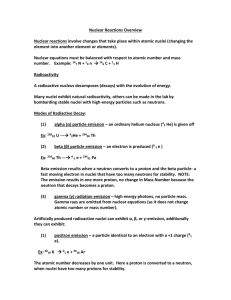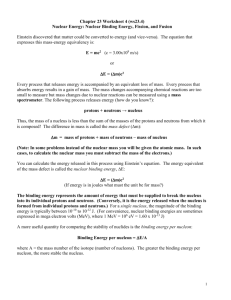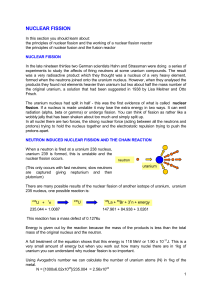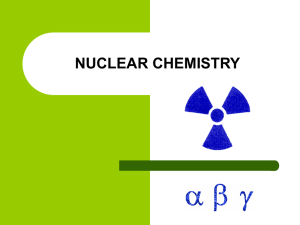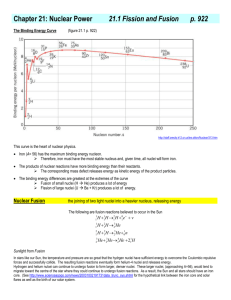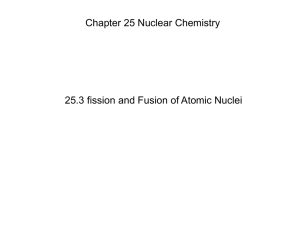Mass-Energy Equivalence
advertisement
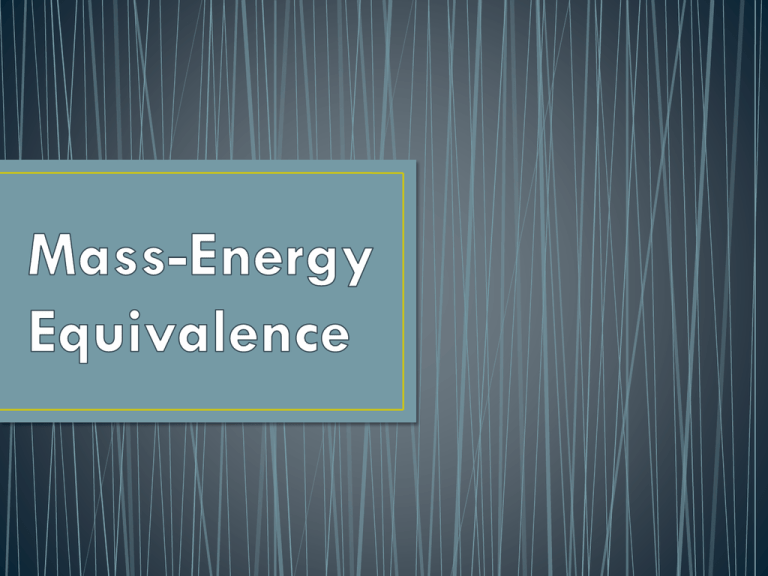
• The equation E = mc2 is probably the most recognized symbol of physics. • This equation tells us that matter and energy are really two forms of the same thing. • If you put enough energy in one place, you can create matter. • If you make matter disappear, you get energy. • The law of conservation of energy becomes a law of mass-energy conservation. • The amount of energy it takes to create a kilogram of matter is calculated using Einstein’s formula. • Nuclear reactions also obey the energy conservation laws. • The total amount of energy before the reaction has to equal the total amount of energy after the reaction. • Energy stored as mass must be included in order to apply the law of conservation of energy to a nuclear reaction. • The energy from mass is given by Einstein’s formula E = mc2 where m is the mass of the particle. • Even small amounts of mass contain tremendous energy because c2 is such a large number… 90,000,000,000,000,000 (Ninety quadrillion!!!) • A fission reaction splits up a large nucleus into smaller pieces. • • • A fission reaction typically happens when a neutron hits a nucleus with enough energy to make the nucleus unstable. Fission breaks the nucleus into two smaller pieces and often releases one or more extra neutrons. Some of the energy released by the reaction appears as gamma rays and some as kinetic energy of the smaller nuclei and the extra neutrons. • A nuclear chain reaction occurs when the fission of one nucleus triggers fission of many other nuclei. • In a chain reaction, the first fission reaction releases two or more neutrons. The two neutrons can hit two other nuclei and cause fission reactions that release four neutrons. The four neutrons hit four new nuclei and cause fission reactions that release eight neutrons. The number of neutrons increases rapidly. The increasing number of neutrons causes more nuclei to have fission reactions and enormous energy is released. The atom bomb is based on the uncontrolled fission of uranium 235 or plutonium 239. In a conventional nuclear power plant, the U235 fission reaction is used to generate electricity. • Today, about 20 percent of U.S. electric power comes from nuclear fission plants. • Nuclear fusion is a nuclear reaction in which two or more atomic nuclei collide at a very high speed and join to form a new type of atomic nucleus. • During this process, matter is not conserved because some of the matter of the fusing nuclei is converted to photons (energy). • Stars, like the sun, make energy from fusion reactions, because the core of a star is both hot and very dense. • All of the energy reaching Earth from the sun ultimately comes from these fusion reactions in the sun’s core. • When a single heavy nucleus splits into two or more lighter nuclei (fission), the sum of their masses is less than the mass of the original nucleus. Some mass is missing, and some energy is released. • When two light nuclei fuse into a single heavier nucleus (fusion), the mass of the heavier one is less than the sum of the masses of the two light ones. Some mass is missing, and some energy is released. • In both events (fission and fusion), the missing mass has been converted to energy. • Radioactive decay, also known as nuclear decay or radioactivity, is the process by which a nucleus of an unstable atom loses energy by emitting particles of ionizing radiation • If the amount of missing mass is 'm', and you multiply 'm' by the square of the speed of light 'c2' , the answer you get is the amount of energy that was released 'e'. • How much energy is contained in matter with a mass of 2kg? E = (2) (3x108)2 E= 1.8x1017 • A piece of carbon-14 that originally had a mass of 2 kg is later found to have a mass of 1.75 kg (due to radioactive decay). How much energy was released? E = (.25) (3x108)2 E= 2.25x1016





